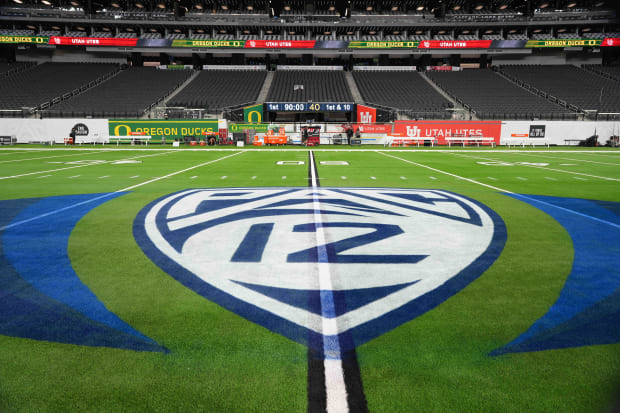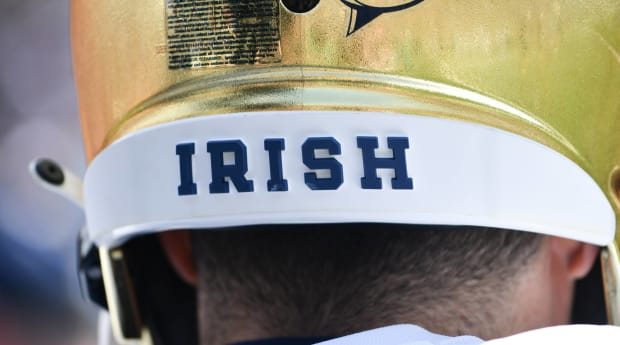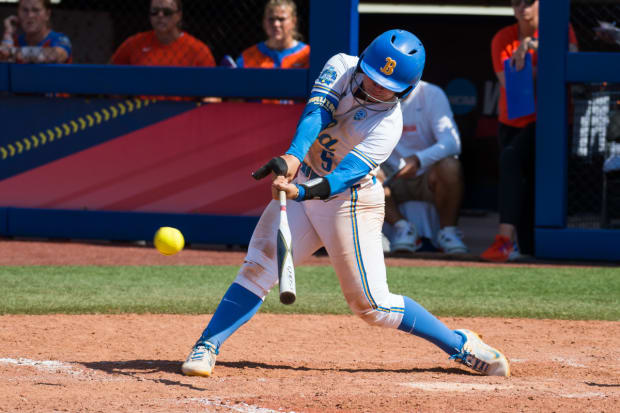Another summer, another wave of upheaval in the college sports landscape.
On Thursday, Big Ten chancellors and presidents voted to accept USC and UCLA into its conference, beginning in 2024. The move comes almost a year after Texas and Oklahoma decided to move from the Big 12 to the SEC.
The seismic shift will no doubt lead to more falling dominoes in the coming months, including an expected new television rights deal for the Big Ten. There are also many questions about the fallout and what’s to come.
Sports Illustrated’s Pat Forde, Richard Johnson and Kevin Sweeney break down the latest.
What happens now to the Pac-12?

Kirby Lee/USA TODAY Sports
Forde: The Pac-12 is in serious trouble, especially if the Big Ten also goes after Oregon and Washington, as has been speculated upon. Even if it’s just USC and UCLA, losing teams in Los Angeles is a crushing blow—athletically, academically, competitively and monetarily. L.A. is the recruiting Mecca of the conference, the biggest TV market, and a potential source of massive name, image and likeness funds. The Big 12 is wobbly but still standing without Texas and Oklahoma, but the Pac-12 could be headed for the canvas face first. It is quite depressing for people who are averse to corporate gigantism as a byproduct of modern college athletics.
Johnson: I’m very curious about what happens to the rest of the Pac-12. There will certainly be rumors that some of the remaining schools might jump to the Big 12, for instance. There are also people who believe the Big Ten isn’t done expanding either. But another burning question around the conference is whether this leads to Stanford and/or Cal deemphasizing athletics or at least football, or will they try to beef up to be the new big dog along with Oregon?
Why UCLA and USC, and not other Pac-12 programs?
Forde: They bring a massive TV market to the Big Ten, open the West Coast to further recruiting plunder, expand the league’s TV window to damn near round the clock and have traditional excellence in many sports. Yes, UCLA is a football underachiever, as is USC men’s basketball; but the Trojans are a legit football blueblood and the Bruins are a legit men’s hoops blueblood. And both excel in Olympic sports. When this goes down, the Big Ten will now have five football stadiums with capacities of 90,000 or more. Big brands, big cities, big revenue dollars.
Johnson: It doesn’t hurt that both teams corner the Los Angeles TV market as the Big Ten looks to negotiate its new TV deal with, coincidentally, West Coast-based Fox Sports. UCLA and USC seem to have made a bet here. The bird in the hand (soon-to-be-completed Big Ten media rights negotiations) trumps betting on the Pac-12’s uncertain future. Both schools have already lived through that league falling behind, and seemingly can’t afford to stick around for the future.
Yeah, we’re all wondering: What about Notre Dame?

Matt Cashore/USA Today Network
Forde: The stubbornly proud independent is inexorably being painted into a corner. The options: remain independent and see if it’s tenable as a big-time athletic power; remain independent and reduce emphasis on athletics; join the ACC in all sports; relinquish at last and join the Big Ten.
Of those four choices, I honestly wouldn’t be shocked to see Notre Dame choose the road less taken and de-emphasize athletics—especially if the Fighting Irish are ultimately joined by the likes of Stanford, California and some of the more academically minded ACC schools (Duke, Georgia Tech, Boston College, Wake Forest, North Carolina, Virginia). Those schools could form their own league, one grounded in more of a traditional college athletic mindset. There might even be an alliance (to use an awkward term of the moment) with the Ivy League. It would be a radical departure for one of the most successful football schools in history, but I believe Notre Dame is serious about keeping athletics tied to an academic anchor.
Johnson: This seems to largely boil down to the ACC trying to find a way to leverage the Irish, but it does appear the drumbeat is back for Notre Dame to become full members again.
How will this impact non-football sports, like basketball and Olympic sports?

Brett Rojo/USA TODAY Sports
Sweeney: For men’s basketball, there are downwind impacts to consider, namely the financial windfall coming to USC, UCLA and the rest of the Big Ten when a new TV deal kicks in. None of those programs were lacking in financial muscle before, so I don’t anticipate a massive change in how these programs operate compared to other high-majors. More immediately, the Big Ten adds one of men’s basketball’s most storied programs to a league that was already perhaps the sport’s best conference. NCAA tournament struggles aside, the Big Ten has been in the top three of KenPom’s conference rankings for four straight seasons. Becoming a truly national conference could help recruiting, particularly in talent-rich California (though college basketball recruiting is already quite national). Besides some inevitable bellyaching about travel schedules that will start to look more like an NBA team, it’s hard to chalk this up as anything but positive for the Big Ten.
Notably, UCLA hasn’t been the highest-ranked Pac-12 team in KenPom since 2007–08, while USC has only taken that crown once within that time period. Still, losing a legacy brand (UCLA) and a consistent NCAA tournament–caliber program (USC) are major blows to a league that was already limited to three Big Dance bids in three of the past five years. Without USC and UCLA, the gap between the Pac-12 and mid-major leagues like the Mountain West and WCC continues to shrink.
Johnson: Both programs house plenty of sports, but not an Ohio State (36) amount. Every sport has a natural home except for the ones that play in the Mountain Pacific Sports Federation, which houses the sports that aren’t carried by the Pac-12. Baseball will have a greater recruiting opportunity and will be a better sell in the baseball hotbed of Southern California. The Pac-12’s softball and gymnastics pedigree are dealt blows here as standard-bearer UCLA goes to the Big Ten. There will be fierce competition in each sport against stalwart Michigan.
Forde: It’s a huge shakeup in other sports, as well. For one thing, midweek travel will be a bigger headache and a huge drain on athletes and coaches. (As noted in my column, if any of these people start talking about squaring this expansion with student-athlete welfare, feel free to laugh in their faces.) The men’s and women’s basketball competitions jump up another level, and both were already very good. USC and UCLA are great in several Olympic sports, some of which have long been weaker areas for the Big Ten.
Factoring in Oklahoma and Texas, as well, what are your new favorite rivalry games?
Forde: Well, I’m just oozing with excitement for those USC-Rutgers games. In non-sarcastic tones, and as an avowed fan of uniform matchups, I already love UCLA-Michigan and USC-Ohio State. Seeing games once largely reserved for the Rose Bowl being played in different stadiums (and with different weather!) should be a blast. In terms of places where rivalry blood will boil, Texas-Texas A&M is the obvious choice. And, hey, when Clemson becomes acquired by the SEC, the Brent Venables-Dabo Swinney matchup will make Oklahoma-Clemson a good one to watch.
Johnson: Fortunately, unlike Texas A&M’s bolt to the SEC, the natural rivalry is preserved. But there is an opportunity for some really cool helmet matchups. There is already the spiritual link between USC and the Big Ten, as their matchups against Ohio State and Michigan are the most played iterations of the Rose Bowl. Seeing those three teams play more often is just going to be pretty cool.
How would you rank the Power 5 now?
Forde: In football terms, it’s still the SEC on top. The Big Ten remains No. 2. Once Oklahoma and Texas depart the Big 12, then the ACC is No. 3 and the Big 12 is No. 4 and the Pac-12 is an even more distant fifth than it already was.
Johnson: If I have to rank five, it’s …
5. Pac-10 (honestly, I’m glad we can use that name again)
4. ACC
3. Big 12 (with or without Texas/OU)
2. Big Ten
1. SEC
What does this mean for the “Power 5”?
Forde: The Power 5 is a dying concept. It already was endangered in recent years as the revenue gap widened between the Power 2 (the SEC and Big Ten) and the Semi-Power 3 (ACC, Big 12, Pac-12). Now, with alliances fractured and distrust the operative spirit of the times, I can’t imagine those five leagues working in concert on much of anything ever again. The strongest will get stronger, the others will regroup and possibly combine forces for survival—a Big 12/Pac-12 merger doesn’t seem far-fetched, although even that could get ugly. (Why, for instance, would the Big 12 have interest in adding Oregon State and Washington State? Could they end up in a modified Mountain West instead?)
All of this will feed into College Football Playoff deliberations, which have always catered to the Power 5. It seems the reluctance of the ACC and Pac-12 to get onboard with an expanded playoff could prove very costly, because the parameters surrounding automatic bids could change dramatically by the time a new format is agreed upon.







